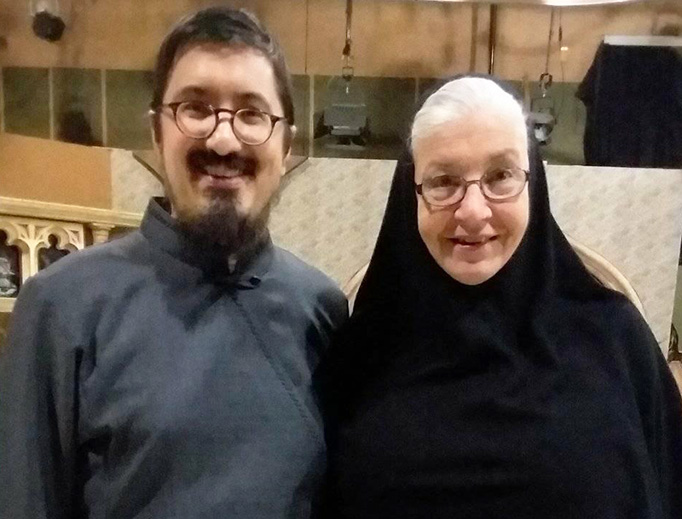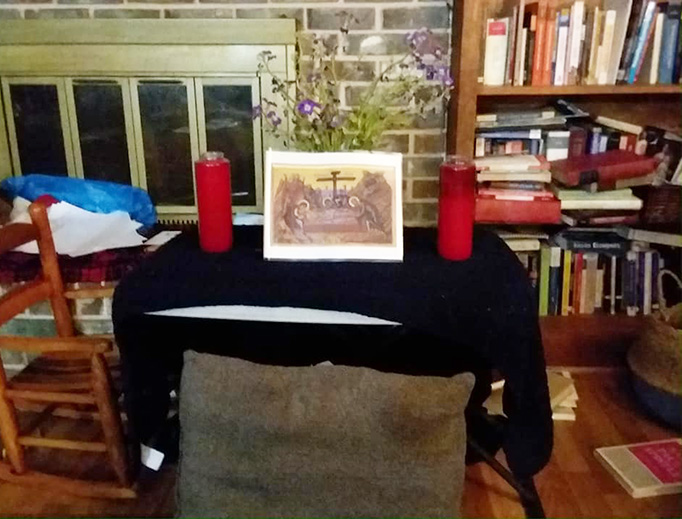These Brides of Christ are the Joy of Christ the Bridegroom
Monasteries uphold the domestic church, and the domestic church is illuminated by the monasteries.

It’s safe to say that 2020 has been a particularly trying year, especially for people of faith. We’ve been separated from our churches, from the sacraments, and from the spiritual nourishment of kinship and community. This year, especially through Lent and the Easter season, life felt especially dry and arid for many. It was within this desert of isolation that a stream of living water was opened up by my favorite Eastern Catholic nuns — the nuns of Christ the Bridegroom Monastery in Burton, Ohio.
The Monastery of Christ the Bridegroom is about a 45-minute ride southeast of Cleveland. It was founded in 2009 and was recently raised to a sui iuris monastery of eparchial right in 2019 by Bishop Milan Lach of the Eparchy of Parma (Ruthenian). The monastery is headed by Mother Theodora, who serves as hegumena (abbess) and currently has three “life-professed” members (also called stavrophore or “cross-bearer”) and two rasophore (“robe-bearer”) members. I was privileged to meet and spend time with Mother Theodora when she appeared on EWTN Live in July 2019. It was clear from my time with Mother that she is a woman who is in love with her vocation and deeply in love with Christ the Bridegroom.

It’s fairly uncommon, among Eastern Catholic monasteries, to identify the community ethos through the image and theology of Christ the Bridegroom. But when you spend time with the nuns, it becomes clear that it is a perfect fit! The striving for union with God, which is the singular occupation of monastic life — and indeed, all Christian life — is well encapsulated by marital imagery. Sister Petra, one of the rasophore nuns, explains:
The Bridegroom is the One Who pursues our souls and beckons us as His Bride, the Church into union with Him, “Arise, my beloved, my beautiful one, and come!” (SOS 2:13) He calls us to union, yearning to penetrate every recess of our hearts with His life-giving Spirit, to bring forth in us spiritual fruit that will last for all eternity. To encounter Christ as Bridegroom is to know yourself sought and desired by God, purchased by a Love “stern as death” (SOS 8:6) It is to respond with the total gift of yourself to the God-Man, Jesus Christ; to know yourself claimed in love. Of course, this union becomes reality in prayer (we call our cell rule the hour of private prayer we each offer each day in our own cells our “spousal prayers”), through which we learn to hear His Voice and reveal ourselves to Him. The Bridegroom is the Fulfillment of all desire, but we in this world we are as yet only espoused to Him: the consummation will only be realized in Heaven. Thus, to turn to Christ as Bridegroom is to live in hope, with faith that “hope does not disappoint us” (Rom. 5:5).
This love of Christ the Bridegroom has produced spiritual fruit for several thousand recently through the monastery’s outreach during Lent and Holy Week. When the churches closed, the nuns (by way of a providential penance) took to building a guide for the domestic Church for Lent and Holy Week (now expanded beyond the Paschal season). Mother Cecilia, who spearheaded the monastery’s efforts, explains:
Our monastic community is a little family whose life revolves around praying together, and we do it almost all of the time without a priest (obviously not the Divine Liturgy though!). So our normal situation is quite similar to what people are experiencing more frequently now: a need to pray together at home, in their domestic churches. All kinds of ideas started pouring into my mind, and I was excited to get them on paper and share them.
The impact of the monastery’s efforts was felt worldwide. The Melkite Eparchy of Newton adapted their guide, along with the Ukrainian Catholic Eparchy of Edmonton. Byzantine Catholics in Argentina were inspired to create their own guide in Spanish and the nuns were contacted by a Byzantine Catholic woman in France to thank them for their guide. Even the Klesko family is indebted to the nuns, as my boys used the guide to construct Christ’s tomb for Great and Holy Friday.

Without the nuns, many would have been scrambling to figure out how to offer their prayers “in the desert” of the current pandemic. The nun’s work was truly a spiritual oasis in troubled times.
As is characteristic of all Eastern Catholic monasteries, hospitality is a key outreach of the community. Of course, the monastery is not currently accepting visitors in their poustinia (a poustinia is s a simple cabin or room to which one goes to pray and fast in silence and solitude, typically for a day) but the present time and the experience of the domestic church is a kind of poustinia experience. Mother Theodora explains:
If we look at the pandemic restrictions through the eyes of God, our eyes will be opened to see them not as a major inconvenience or an occasion for boredom, but as a beautiful invitation to take the time to be alone with God and to love and trust Him in a deeper way, personally and as a family. It’s an opportunity to intentionally make the time and create a place to be in solitude with the Lord. Schedule a daily time and place for the family to gather together in the hope and spirit of Jesus’ words, “For where two or three are gathered in My name, I am there among them” (Matthew 18:20), even if for only 10 or 15 minutes. It’s not so much about what we do in prayer, but what we allow God to do within us.
We can appreciate during this time of quarantine and uncertainty that the monastic vocation is upholding and supporting the domestic church. This is where the monastic life touches on an important reality, namely that, “[In the East], monasticism was not seen merely as a separate condition, proper to a precise category of Christians, but rather as a reference point for all the baptized…” (Orientale lumen, 9 ). We are not separated by our vocations, monastic and lay — rather, we are united by our common faith and baptism. Monasteries uphold the domestic church, and the domestic church is illuminated by the monasteries. This mutual enrichment is the fruit of all the baptized who are seeking union with Christ the Bridegroom. The nuns remind us of this reality and they live it out so joyfully! Once this pandemic is behind us, plan a visit to say “thank you” to these beautiful brides of Christ.
For more information visit, http://www.christthebridegroom.org/.
- Keywords:
- eastern catholicism
- poustinia















